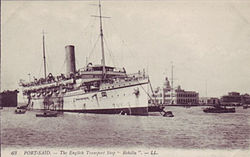HMHS Rohilla
|
||||||||||||||||||||
|
||||||||||||||||||||
|
||||||||||||||||||||
|
||||||||||||||||||||
|
||||||||||||||||||||
The Rohilla was a steamship of the British shipping company British India Steam Navigation Company put into service in 1906 , which was initially used as a combined passenger and cargo ship and briefly served as HMHS Rohilla (His Majesty's Hospital Ship) as a hospital ship during the First World War . The Rohilla ran on October 30, 1914 on the north east coast of England on the reef Whitby Rocks and was a total loss . Of the 229 people on board, 84 were killed despite an extensive rescue operation.
The ship
The 7,114 GRT steel-built steamship Rohilla was built at Harland & Wolff shipyard in Belfast, Northern Ireland for the British India Steam Navigation Company. The ship was launched on September 6, 1906 and was 140.28 meters long, 17.14 meters wide and had a maximum draft of 9.29 meters. The two quadruple expansion steam engines produced 8,000 PSi . The load capacity was 7,460 tons. The Rohilla was completed on November 16, 1906 and handed over to its owners the following day.
The ship had three single-end and three double-end boilers with a total of 27 firing systems . The top speed was 16.6 knots (30.7 km / h). The Rohilla had two masts , a chimney and two propellers . It was used for passenger traffic from London to Calcutta and drove from Southampton to Karachi in the winter months . The ship could take 100 first class and 65 second class passengers on board. The crew consisted of 175 people.
Her sister ship was the Rewa (7,308 GRT) launched on February 14, 1906 at William Denny and Brothers . Both ships were registered in Glasgow and designed as passenger ships. In 1908 both were withdrawn from passenger traffic and converted into troop transports . The Rewa became Troop Carrier No. 5, the Rohilla No. 6. In 1910 the Rohilla members of the House of Lords were brought to Spithead for the Coronation Fleet Review of King George V. The Rewa transported members of the House of Commons to the same event. In the same year, both steamers were the first ships of the British India Steam Navigation Company to be equipped with radio systems.
In the first World War
After the outbreak of World War I , both the Rohilla and the Rewa were requested by the Royal Navy and converted into hospital ships. On August 6, 1914, the Rohilla was called in and rebuilt immediately. It received the typical white-green paint. On the same train she was equipped with X-ray machines.
On August 16, 1914, the ship ran from Southampton for operational exercises to Scapa Flow . While the Rohilla was in Scapa Flow, Prince Georg was brought on board, who was suffering from appendicitis at the time . The Rohilla was then sent to Aberdeen , where the royal personal physician had been sent. There the prince was operated on successfully.
Downfall
On Thursday, October 29, 1914, the HMHS Rohilla ran under the command of Captain David Landles Neilson (50) in Leith (Scotland) for a crossing to Dunkirk . New patients should be taken on board there. At around 4:00 a.m. on October 30, the ship ran into the infamous Whitby Rock reef in Saltwick Nab Bay, about a mile south of the port city of Whitby . Because of the strict war regulations, the coasts were darkened so that the ship had lost its course and got too close to the shore. Captain Neilson was unfamiliar with the waters and he wasn't sure if German submarines or sea mines were to be expected in the area.
Although the Rohilla was stranded only 600 meters from land and six lifeboats of the Royal National Lifeboat Institution from Teesmouth, Whitby, Upgang, Scarborough and Tynemouth immediately came to the scene of the accident, the rescue operation proved to be difficult. The sea, churned by an approaching storm, smashed Rohilla, who was sitting on the rocks . Of the 229 crew members, doctors and nurses on board, 84 were killed as a result of the accident. The last 50 survivors were only recovered after more than two days. Among those rescued was the nurse Mary Roberts, who had survived the sinking of the Titanic as a stewardess and then served on the Majestic . She described the Rohilla's misfortune as "more gruesome" than that of the Titanic .
The rescue workers were awarded a total of three gold medals and four silver medals. Major Herbert E. Burton, captain of the Tynemouth lifeboat, accepted the Empire Gallantry Medal on June 30, 1924, and Richard Eglon, Whitby's second helmsman , was honored with a special honor by the residents of Tyneside. Both Captain Neilson and his officers initially assumed they had run into a sea mine . They confirmed this in the judicial investigation that followed the accident under the supervision of examining magistrate George Buchanan. The examinations of the wreck and the testimony showed, however, that the Rohilla had walked on rocks and this had led to its sinking. Captain Neilson was acquitted of all guilt for the loss. According to the court, he had tried everything to save his ship. Shortly thereafter, the shipping company erected a memorial in Whitby cemetery, where the victims were buried.
literature
- Colin Brittain. Into The Maelstrom: The Wreck of HMHS Rohilla . Tempus (2002)

